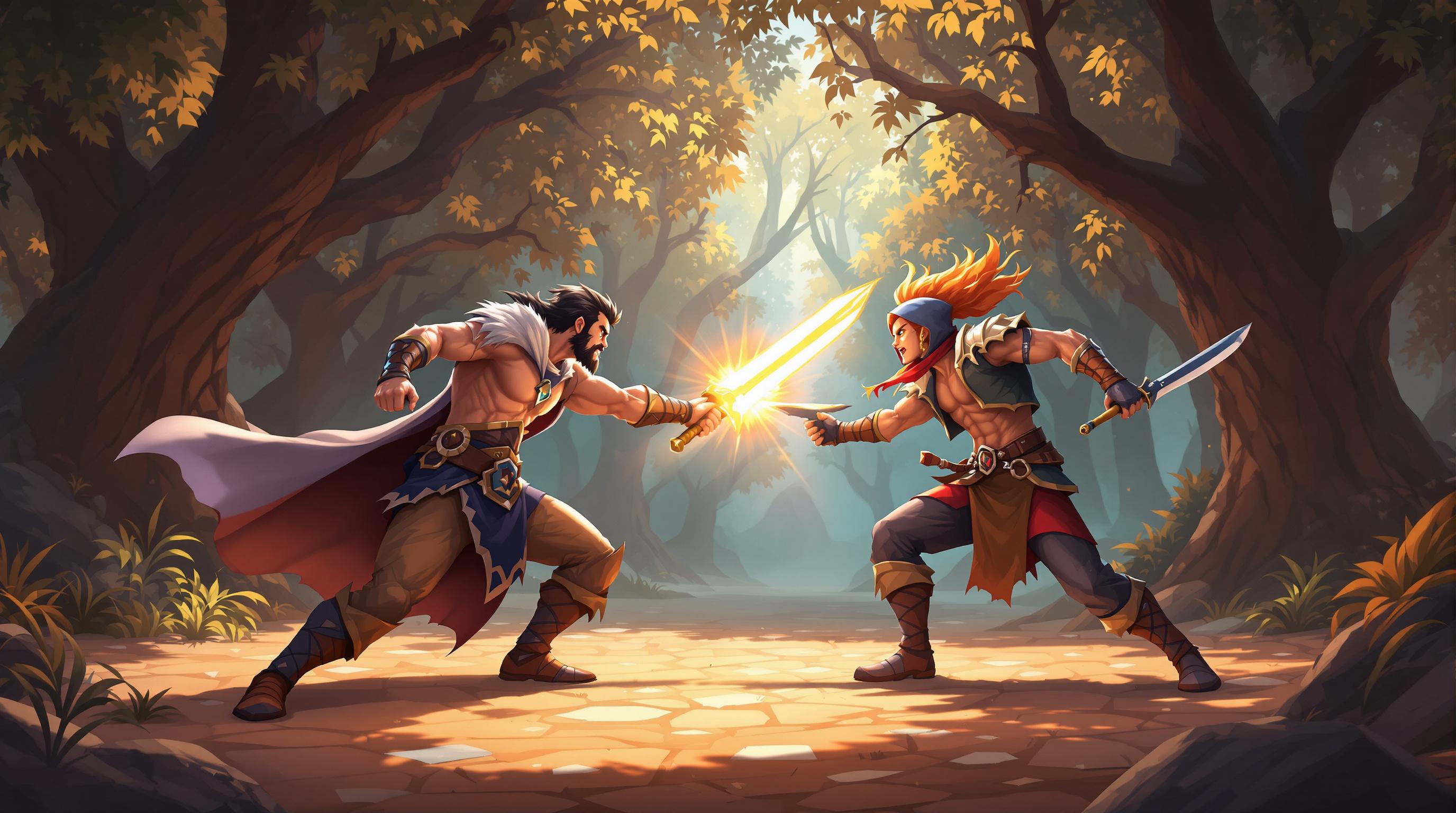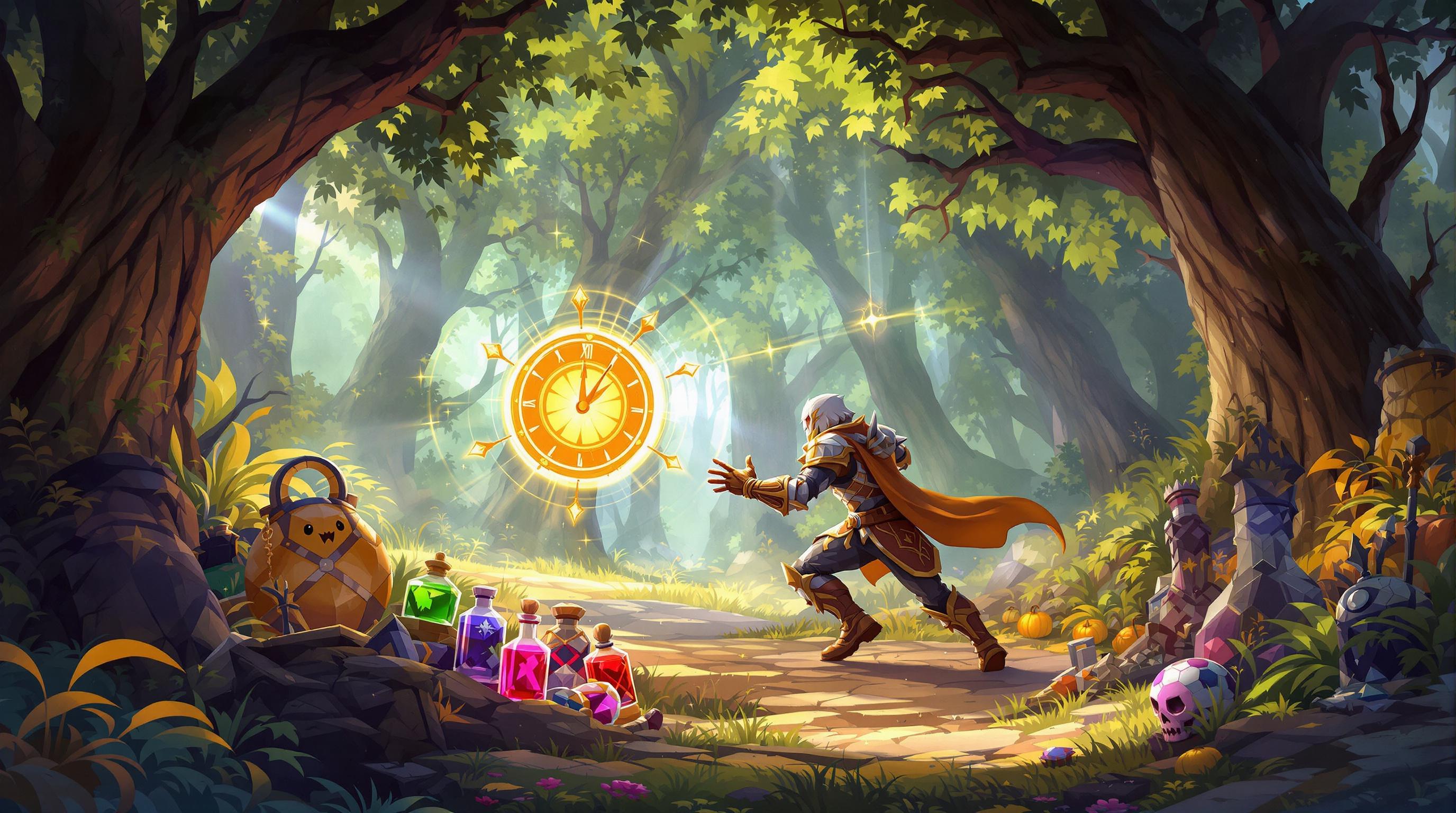When the world falls apart, tabletop RPGs let you step into the chaos and make tough choices. This article covers five standout post-apocalyptic TTRPGs that explore survival, scarcity, and rebuilding in unique ways. Each game offers something different, from gritty realism to bizarre mutations, letting you tailor the experience to your group’s style. Here’s the quick rundown:
- Mutant: Year Zero: Focuses on survival and community building in a wasteland, with a "push your luck" mechanic and mutation-driven chaos.
- Apocalypse World: A character-driven story about power struggles and alliances, using simple, narrative-focused rules.
- Gamma World: A quirky, unpredictable game filled with mutations and strange tech in a chaotic world.
- Twilight: 2000: A grounded, military-themed survival game with tactical combat and resource management.
- Legacy: Life Among the Ruins: Explores rebuilding civilizations across generations, blending personal and faction-level storytelling.
Each game caters to different playstyles, from tactical depth to improvisational drama. Whether you want to manage scarce resources, shape a society’s future, or dive into chaotic adventures, there’s a game here for you.
Surviving the Post-Apocalypse - Twilight 2000 4e RPG Overview
Quick Comparison
| Game | Focus | Complexity | Best For |
|---|---|---|---|
| Mutant: Year Zero | Survival, community building | Medium | Teams managing resources and rebuilding |
| Apocalypse World | Relationships, power dynamics | Low-Medium | Roleplay-heavy groups |
| Gamma World | Chaos, mutations, humor | Medium-High | Fun, unpredictable adventures |
| Twilight: 2000 | Realistic survival, military | High | Tactical, strategy-focused players |
| Legacy: Life Among the Ruins | Generational storytelling | Medium-High | Long-term world-building campaigns |
Pick the one that fits your group’s vibe and dive into the apocalypse!
1. Mutant: Year Zero
Mutant: Year Zero takes players into the Ark, a fragile sanctuary where mutants, robots, and humans cling to survival amid the ruins of civilization. Published by Free League Publishing, this Swedish tabletop RPG combines post-apocalyptic despair with a glimmer of hope, offering a unique twist: it’s not just about staying alive - it’s about rebuilding and sustaining a community. This focus on collective survival sets the stage for its distinct mechanics and gripping storytelling.
A World of Ruin and Mystery
The Ark is a sanctuary, but it’s far from paradise. Here, Pure Humans, Mutants, and Robots coexist uneasily, bound together by necessity. Outside the Ark lies the Zone, a wasteland filled with relics of the old world, lurking dangers, and the promise of answers. The tension between the Ark’s fragile safety and the Zone’s perilous unknown drives much of the game’s drama.
What makes this world especially engaging is the mystery woven into its fabric. The Elder Council guards secrets about the past, while strange artifacts hint at lost technologies. Instead of spoon-feeding players the backstory, the game encourages exploration and discovery. Piece by piece, players uncover the truth behind the Great Dying - the catastrophic event that ended the old world.
Survival with High Stakes
Survival in Mutant: Year Zero isn’t just a backdrop; it’s woven into every roll of the dice. The Push Your Luck mechanic forces players to weigh risk and reward. Push too hard, and you might damage your gear or stress your character, but sometimes taking that gamble is the only way forward. It’s a system that mirrors the desperation of life in a crumbling world.
Resource scarcity adds another layer of tension. Supplies in the Ark are dwindling, making expeditions into the Zone a necessity. Every scrap of food, every bullet, every battery becomes a lifeline. Players must constantly decide between immediate survival and the long-term needs of their community. These choices create a sense of urgency and make every decision feel impactful.
A Narrative That Ties It All Together
The storytelling in Mutant: Year Zero goes beyond the usual survival tropes by focusing on relationships and personal goals. Each character has a Big Dream - a driving ambition that shapes their actions - and connections to other characters that can lead to bonuses or complications. These relationships ensure that the story isn’t just about surviving another day; it’s about the bonds that form under pressure.
Adding to the unpredictability is the mutation system. When mutant characters push their abilities, they risk developing new mutations. These changes can be helpful, harmful, or downright bizarre, adding an element of chaos that keeps players on their toes. It’s a clever way to reflect the uncertainty of life in a broken world.
Growth Through Struggle
Character development in Mutant: Year Zero captures the duality of survival: triumph and trauma. The stress system leaves psychological scars, opening the door for roleplay around resilience and mental health. Success may come at a cost, but those scars tell a story of perseverance.
The game also encourages players to shape the Ark’s future. Through development projects - like building facilities, forming trade routes, or rediscovering lost knowledge - characters can leave a lasting legacy. These projects tie personal achievements to the community’s survival, making every choice resonate far beyond the individual.
2. Apocalypse World
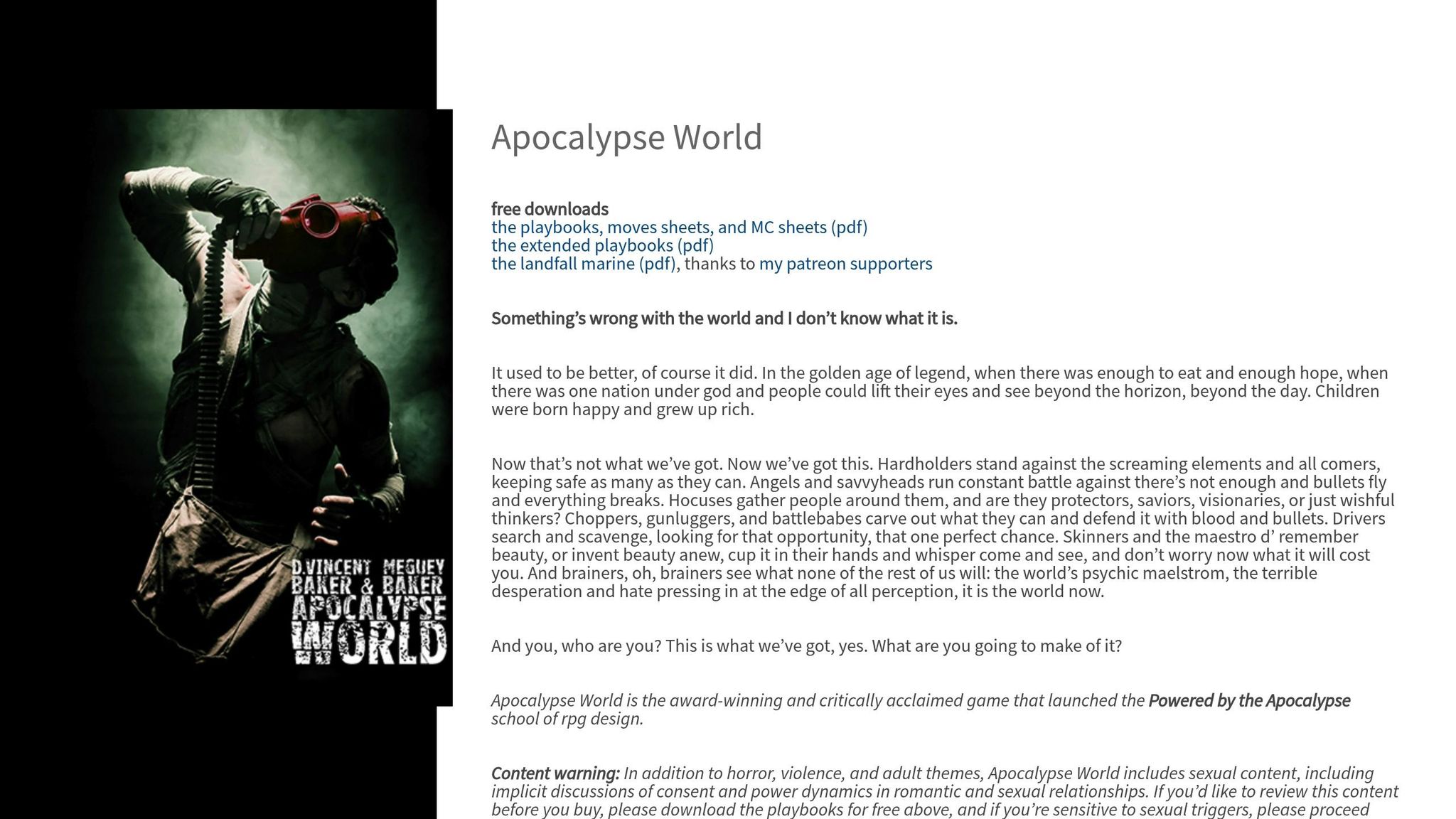
Apocalypse World is the game that sparked the Powered by the Apocalypse (PbtA) movement, created by D. Vincent Baker and Meguey Baker. It flips the script on traditional survival games by focusing on human drama and ever-shifting alliances rather than the tedious tracking of resources. This approach opens the door to exploring the messy, often unpredictable dynamics of a collapsing society.
Post-apocalyptic Themes and Setting
The game’s setting plunges players into a world where society has crumbled, and survival depends on navigating factional tensions and personal ambitions. Instead of obsessing over food rations or ammunition, the spotlight is on fragile alliances, power struggles, and the constant threat of betrayal. Game Masters are encouraged to create a harsh, unpredictable world where danger doesn’t just come from the wasteland but from the tangled web of human relationships and rival factions vying for control.
Storytelling Mechanics
What makes Apocalypse World stand out is its groundbreaking "moves" system. These narrative prompts drive the story forward whenever players act, ensuring that every choice has immediate and often unexpected consequences. Whether players succeed or fail, the story evolves, keeping the drama alive. This dynamic interaction between players and the Game Master ensures that the narrative remains fluid and full of surprises.
Character Development and Player Engagement
In Apocalypse World, character growth is tied to the harsh realities of the post-apocalyptic setting. Players develop their characters by leaning into their personal drives and dealing with the fallout of their decisions. The game’s Hx system shines here, rewarding players for building layered relationships - whether those connections are rooted in trust, rivalry, or something in between. Every triumph, failure, or betrayal weaves into the larger narrative, creating a story where survival is as much about personal transformation as it is about staying alive. It’s a relentless battle to find hope in a world steeped in despair.
3. Gamma World
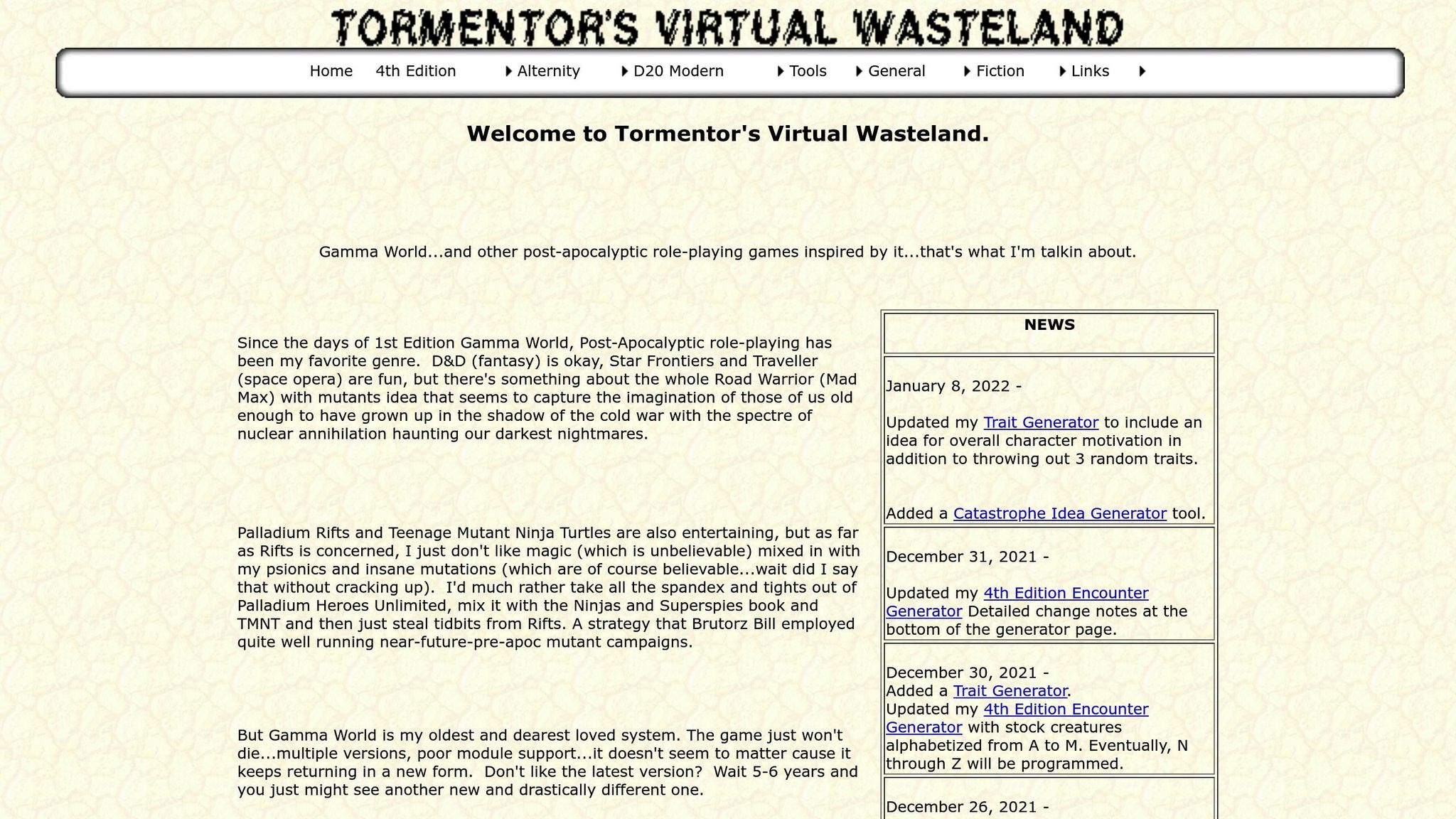
Gamma World is a wild mix of dark humor, sci-fi eccentricities, and post-apocalyptic chaos. First published by TSR in 1978 and later revamped by Wizards of the Coast, this game thrives on unpredictability. Its core appeal? Adventures shaped by bizarre mutations that throw players into a world where survival means embracing the unexpected.
Post-apocalyptic Themes and Setting
The game unfolds in a shattered world, the aftermath of a catastrophic event that left civilization in ruins. In this unforgiving landscape, mutated creatures roam freely, and ancient technological relics are as dangerous as they are useful. These artifacts might grant incredible powers - or unleash disastrous consequences. This constant uncertainty adds an edge of excitement and danger, making every encounter feel like a gamble. The setting itself plays a pivotal role in creating a dynamic, ever-changing experience.
Survival and Adaptation
Survival in Gamma World is never straightforward. Players face a barrage of random mutations and environmental threats that can either help or hinder their journey. Every step forward requires quick thinking and the ability to adapt to whatever the game throws their way.
Character Evolution and Development
Character growth in Gamma World is anything but ordinary. As players progress, their characters develop strange new mutations and abilities that can completely shift how they approach challenges. Imagine gaining an unexpected power that turns the tide of a battle or opens up a creative solution to a problem. This evolution isn’t just about surviving - it’s about thriving in a world where the bizarre becomes the norm.
sbb-itb-b8b00a5
4. Twilight: 2000
Twilight: 2000 takes a grounded, military-focused approach to survival storytelling. First released in 1984 and reintroduced in 2021, this game puts players in the roles of soldiers stranded in a world devastated by World War III. Forget supernatural creatures or magical powers - this is a game about human endurance and the raw challenges of a crumbling society. Its military backdrop creates a gripping narrative of resource scarcity and the bonds forged under extreme pressure.
Post-apocalyptic Themes and Setting
The year is 2000, and nuclear war has obliterated civilization across Europe and beyond. Players step into the shoes of military personnel who are cut off from their chain of command, struggling to survive in a world where governments have collapsed and resources are scarce. This isn't a fantastical apocalypse filled with monsters - it's a stark and realistic vision of societal breakdown.
What makes the game stand out is its authentic military atmosphere. Players face physical threats like radiation and hostile survivors, but the psychological toll is just as heavy. Being far from home, with no clear mission or purpose, adds a layer of emotional depth. The game explores how ordinary people adapt and endure when the structures they relied on vanish overnight.
Survival and Resource Management Systems
In Twilight: 2000, every decision matters because every resource is precious. Bullets, fuel, food - each has to be carefully tracked and rationed. Unlike games where supplies magically appear, here you feel the weight of scarcity. Every shot fired and every gallon of gas burned carries consequences.
Vehicles play a critical role in survival. Entire game sessions can revolve around fixing a broken-down truck or scavenging for spare parts. Fuel becomes as valuable as currency, and having a functional vehicle can mean the difference between life and death.
Medical care is equally unforgiving. Injuries heal slowly, and untreated infections can be fatal. Medics and medical supplies become lifelines, fostering teamwork as players must rely on each other to make it through.
Player Engagement Through Character Development
Survival in Twilight: 2000 isn't just about managing resources; it's about how characters grow and adapt to their harsh realities. Skills develop through necessity. A tank mechanic might gradually pick up scavenging or field medicine simply because the group needs it. This organic progression feels natural and reinforces the game's survival themes.
The constant threat of danger and scarcity strengthens bonds between players and their characters. Every team member becomes indispensable, and this creates natural tension as tough decisions arise. Who gets the last of the medical supplies? Do you risk helping strangers or focus on your group’s survival? These moments lead to compelling drama and force players to weigh individual needs against group loyalty.
Leadership dynamics also emerge naturally. With no clear military hierarchy, someone has to step up and make tough calls - whether it’s choosing a route, deciding how to allocate supplies, or determining whether to assist refugees. These decisions create rich role-playing opportunities that feel true to the military setting and the game’s themes of survival and resilience.
5. Legacy: Life Among the Ruins
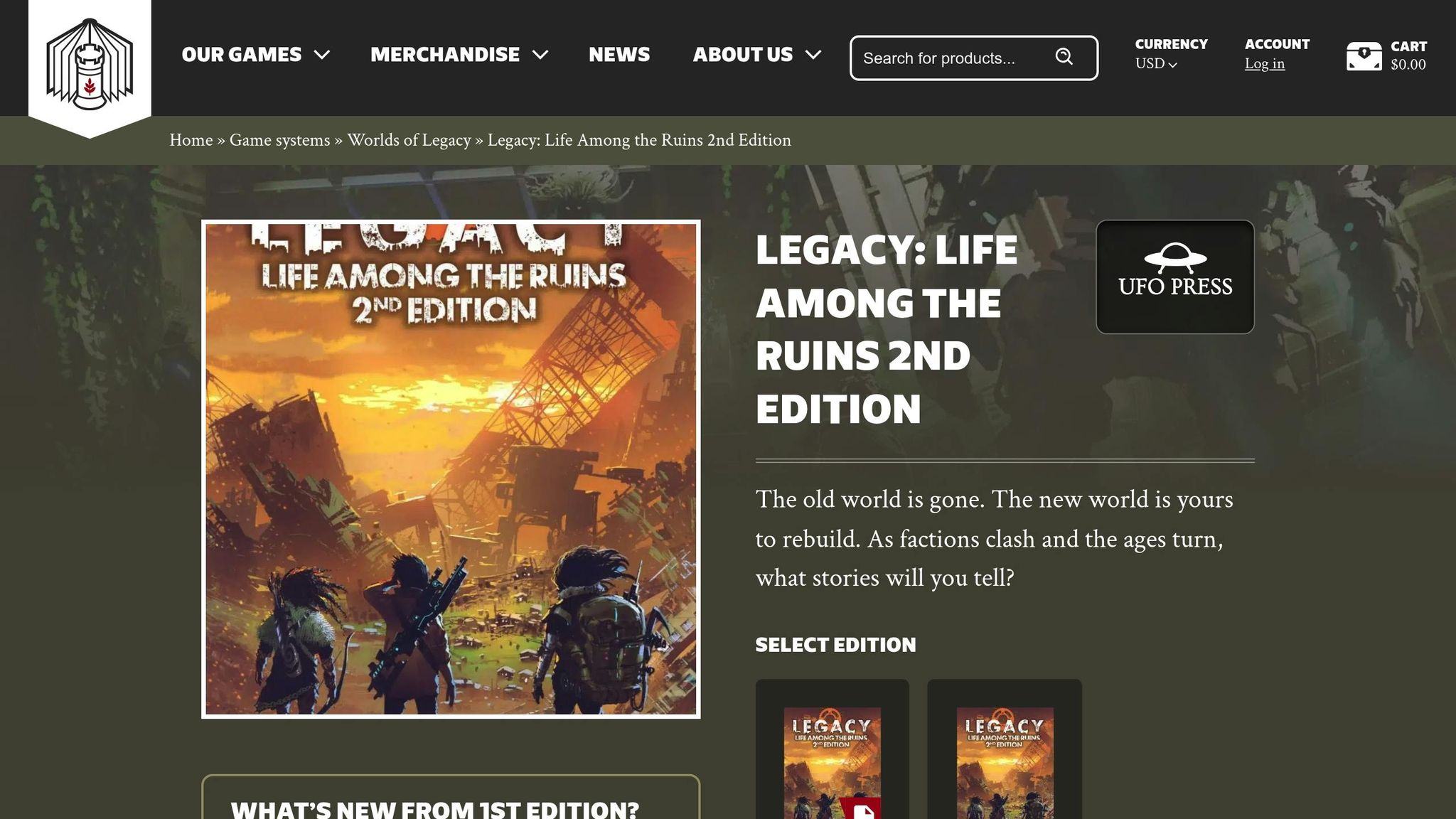
Unlike earlier games that focus on short-term survival and managing scarce resources, Legacy: Life Among the Ruins takes a broader view, exploring the ripple effects of choices across generations. This post-apocalyptic RPG shifts the focus from immediate struggles to the long-term rebuilding of society, encouraging players to create legacies that shape the future.
What makes this game stand out is its dual-scale mechanics. Players balance the lives of individual characters dealing with present-day challenges while also guiding entire factions whose decisions influence society for decades. This dynamic creates a narrative where small, personal actions lay the groundwork for sweeping civilizational changes.
Game Comparison Table
Looking for the perfect tabletop RPG (TTRPG) to match your survival story? Each of these games brings something different to the table, from unique mechanics to distinct themes. Below is a summary of their standout features to help you decide.
| Game | Key Strengths | Primary Themes | Mechanical Complexity | Play Style | Best For |
|---|---|---|---|---|---|
| Mutant: Year Zero | Resource management, mutation mechanics, zone exploration | Balancing hope and despair, community building, survival against environmental hazards | Medium | Team-based settlement building with risky expeditions | Groups that enjoy base-building and uncovering a mysterious world over time |
| Apocalypse World | Narrative-driven rules, character interaction, improvisation | Exploring human nature, power struggles, moral dilemmas | Low-Medium | Quick-paced, character-centered storytelling | Players who love roleplay and interpersonal drama over combat |
| Gamma World | Wacky mutations, unpredictable tech, humor | Absurd survival, adapting to strange technology, chaotic exploration | Medium-High | Action-packed adventures with plenty of surprises | Groups who want a lighter, more experimental tone with unexpected twists |
| Twilight: 2000 | Military realism, tactical combat, resource scarcity | Survival under pressure, leadership, and strategic planning | High | Gritty military simulation with detailed mechanics | Players seeking an authentic, tactical military experience |
| Legacy: Life Among the Ruins | Generational storytelling, faction dynamics, long-term impact | Civilization rebuilding, legacy creation, societal transformation | Medium-High | Expansive campaigns with character and faction-level play | Groups that love world-building and exploring the consequences of their decisions over time |
Each game offers a distinct flavor of survival storytelling. Mutant: Year Zero emphasizes strategic resource use and community growth, while Apocalypse World thrives on character-driven drama and improvisation. If you're looking for something more chaotic, Gamma World delivers with its wild mutations and unpredictable tech. For a gritty, realistic approach, Twilight: 2000 focuses on military tactics and survival. Meanwhile, Legacy: Life Among the Ruins spans generations, letting you shape a civilization's destiny over decades - or even centuries.
The mechanics also vary widely. Apocalypse World keeps things simple with a 2d6 system, perfect for fast-paced storytelling. On the other hand, Twilight: 2000 leans into detailed tactical rules for those who love crunch-heavy gameplay. Somewhere in between, Gamma World uses a d20 system with plenty of room for unpredictable outcomes.
When picking your game, think about the tone and themes your group enjoys. Want serious military drama? Twilight: 2000 has you covered. Prefer a more whimsical, anything-goes vibe? Gamma World lets you battle mutant plants and rogue robots. Whether you're drawn to careful planning, spontaneous roleplay, or epic world-building, there's a game here to match your group's style.
Conclusion
Post-apocalyptic TTRPGs offer something for everyone, from gritty realism to wild, mutant-filled escapades. Each of the five games we’ve explored brings its own flavor to the survival genre, letting you tailor your post-apocalyptic story to your group’s unique preferences.
Mutant: Year Zero is perfect for players who enjoy starting from scratch and watching their world grow. Its mutation system adds an evolving twist, balancing moments of hope with the harshness of survival.
Apocalypse World keeps things raw and personal. By stripping away complicated rules, it shifts the focus to relationships and conflicts between characters, creating an improvisational experience where every session takes unexpected turns.
If your group craves tactical depth, Twilight: 2000 delivers a grounded, military-style challenge. With its detailed combat mechanics and resource management, every choice feels crucial, and every bullet counts.
On the other end of the spectrum, Gamma World embraces the chaotic and bizarre. Its unpredictable mutations and quirky technology make for a fun, offbeat take on survival. Who says the end of the world can’t be a little weird?
For those who dream bigger, Legacy: Life Among the Ruins offers a chance to shape entire civilizations. Its generational gameplay and faction mechanics let you explore how your choices ripple through time, creating a truly epic narrative.
These games cover a wide range of playstyles, ensuring there’s something for every group. Want to focus on building communities and managing resources? Mutant: Year Zero is your go-to. Prefer character-driven drama with minimal rules? Apocalypse World has you covered. For tactical combat enthusiasts, Twilight: 2000 offers an intense, military-focused experience.
Think about your group’s play style, the level of complexity you’re comfortable with, and the themes that spark your imagination. Whether you’re drawn to careful planning, dramatic character arcs, or sweeping generational sagas, these games provide everything you need to dive into unforgettable post-apocalyptic adventures. Pick the one that fits your group best, and let the story unfold.
FAQs
What should I consider when picking a post-apocalyptic TTRPG for my group?
When picking a post-apocalyptic TTRPG, it’s important to focus on a few factors to make sure it matches your group’s play style. Start with game mechanics - does your group enjoy complex systems with detailed rules, or do they prefer a simpler, fast-paced style? This choice can really shape how the game feels at the table.
Next, think about the themes and tone. Are you aiming for gritty survival, intense resource management, or a more emotionally charged narrative? Picking a game that aligns with the type of story you want to tell is key.
Also, consider the setting flexibility. Some games let you customize the world to your heart’s content, while others stick to a well-defined universe. Decide which approach works best for your group’s creativity and preferences. Finally, figure out if your group leans toward a realistic survival vibe or if they’d rather dive into something more cinematic and action-filled.
Matching these elements to your group’s preferences will help create an exciting and memorable experience for everyone around the table.
What are the key differences between the mutation mechanics in Mutant: Year Zero and Gamma World, and how do they affect gameplay?
In Mutant: Year Zero, mutations function as structured abilities that players can activate using Mutation Points. This setup allows for more strategic gameplay, letting players decide the best moments to unleash these abilities, making them feel like dependable tools in the heat of the action.
On the other hand, Gamma World takes a completely different approach. Mutations here are unpredictable, with effects that can swing wildly between helpful and harmful. This randomness injects a sense of chaos into the game, forcing players to think on their feet and adapt to sudden twists.
The two games offer unique experiences: Mutant: Year Zero leans toward careful planning and strategy, while Gamma World thrives on spontaneity and improvisation. These contrasting approaches to mutations give each game its own distinct personality, shaping how players interact with the world and each other.
Is Legacy: Life Among the Ruins better for long-term campaigns, or can it work for shorter sessions too?
Legacy: Life Among the Ruins works best for long-term campaigns, as its mechanics are built to delve into the growth and transformation of families and communities over generations in a post-apocalyptic setting. The game truly comes to life when players invest time in developing their characters and seeing how their choices ripple through the world over time.
Although the game can be adjusted for shorter sessions, its focus on detailed storytelling and world-building makes it far more engaging when played over an extended period. If you're after a deep, evolving narrative experience, Legacy is a fantastic option.

